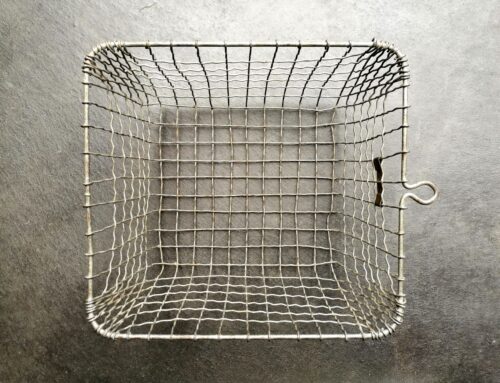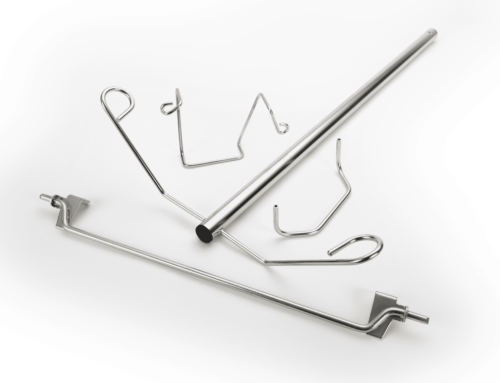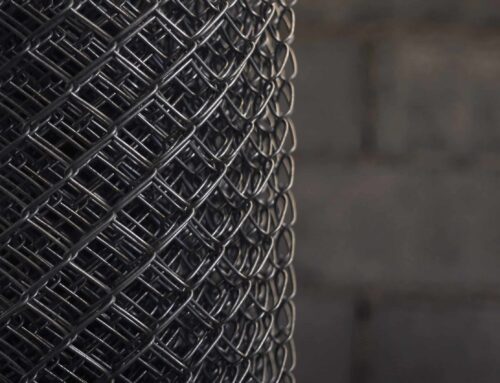The number of wire shapes, configurations, and forms is endless since new ones are constantly being developed. Wire forming can produce any shape imaginable from complex intricate 3 dimensional designs to simple hooks and springs. Many of the things we use have involved some form of wire forming.
Types of Wire Forms
Wire Baskets:
Wire Baskets are used for bulk storage of parts, equipment, and components. They are made of a welded wire mesh. Some forms have a rust-resistant electrogalvanized finish to prevent wear and rusting. The open mesh design provides excellent strength, inventory control, visibility, and forklift access. In production facilities, they can be used to strategically place parts for easy access.
Wire Screens:
Wire screens have thin metal woven wires that are crisscrossed horizontally and vertically to form an open protective barrier to limit access and material flow. The intersecting wires are welded or woven. The wire used in the process is shaped by one of the various wire forming processes to the appropriate diameter. With the welding process, the rows and columns are welded together at their intersection by a preprogrammed machine. With woven wire screen, the process is similar to woven cloth where the wire goes over and under at perpendicular intersections.
Wire Guards:
There are many forms of wire guards that are designed to prevent access to equipment, passageways, instruments, and sensitive materials. Hinged wire guards, or wire cages, are used to protect sensitive equipment in high traffic areas from the activities associated with manufacturing locations and athletic fields. Open face wire guards prevent the activation of fire alarms or emergency stop switches. They are used to enclose automated and robotic machinery, tanks, heavy equipment, motors, and spiral HVAC fans.
R Clips:
R-clips, which are known by a wide variety of names, are fasteners made of metal wire and have the shape of the letter R. They have a similar use to that of a linchpin and are used to secure the end of an axle or rod a wheel. The long straight portion of the clip fits through a hole at the end of the shaft, while the springy part goes over the shaft at the top or bottom. The semi-circular, bent part, fits snuggly on the shaft. To ease the insertion of the pin into the hole on the shaft, the end of the semi-circular part is bent upward, as seen in the image below.
Z Clip:
Z clips are used to lock components in place. The long portion of the Z clip slips over the item to be held and is anchored at both ends to form a secure hold. They come in a wide range of thicknesses and diameters depending on how they are used. Very small Z clips are used to hold electronic computer components. The benefits of Z clips are their strength, versatility, and resistance to corrosion.
Threaded Wire Forms:
In the wire form threading process, a metal rod is rolled through a set of threading dies that create the peaks and valleys of the threads. The process produces threads with high strength in fast cycle times. Unlike the rolled threading process, cut threading removes metal from the workpiece to create the threads and can be used with a wider range of diameters, thread lengths, and pitch combinations.
Hose Clamps:
Wire hose clamps use heavy wire that is bent into a U shape, which is formed into a ring with one end of the wire overlapping the other end. The two ends are bent upward so they can be opened. When the bent ends are pushed apart, they tighten around the hose and provide equal pressure to seal off the hose from leaks. To loosen the clamp, the bent ends are pushed together.
Wire Displays:
Wire displays are a durable and inexpensive means of displaying products. They are produced by bending, shaping, and forming wire made of low, medium, or high carbon steel but can also be made of stainless steel, copper, and aluminum brass. Once they are wire formed, they can be coated, plated, or painted.
Linchpins:
Linchpins are inserted into the end of an axle to prevent wheels from coming off. They are made from aluminum, zinc, brass, and stainless steel.
Utility Hook:
Utility hooks have a threaded end and hook, which allows for easy installation. A utility hook requires multiple bends during the manufacturing process including an offset bend to both sides of the loop with a bend at the end of the loop that touches the other side.
S Hook:
Both ends of an S hook are bent to form the S shape. They are normally used for hanging storage or for organizing cables, hoses, and cords as a safety measure.
J Hook:
There are many varieties of J hooks with the most common being the fishhook. They can be coated for protection of materials placed on them and have notches so they can be hung. Double J hooks are capable of holding huge loads when attached to a strap.
Springs:
Of all the types of wire forms, springs are the most common and widely used. They are a coil that has been wound into a tightly wrapped spiral to meet preset tension requirements. The type of spring depends on how it will be used and its application.
CONTACT ACME WIRE PRODUCTS
Acme Wire Products has designed, recommended, and manufactured custom wire components for customers in many diverse markets. We offer the benefit of our almost 50 years of experience in the manufacture of component parts for hardware, medical & lab equipment, cable management, sporting goods, firearms, furniture, guarding, HVAC, pharmaceutical, automotive, optical, and food service, and processing industries.
Acme Wire’s designers work with our customers to create a wire component that will provide the greatest functional value. The design of wire products such as levers, handles, supports, rings, guards, baskets, trays, grids, frames, and shelves is limited only by one’s imagination (and the limitations of technology).
Contact Acme Wire Products to assist you in determining the wire product best suited to your requirements!
Call Acme Wire Products at 1-800-723-7015 to get started.
Acme Wire Products Co., Inc. – Mystic, CT
Fax – 860-572-9456





